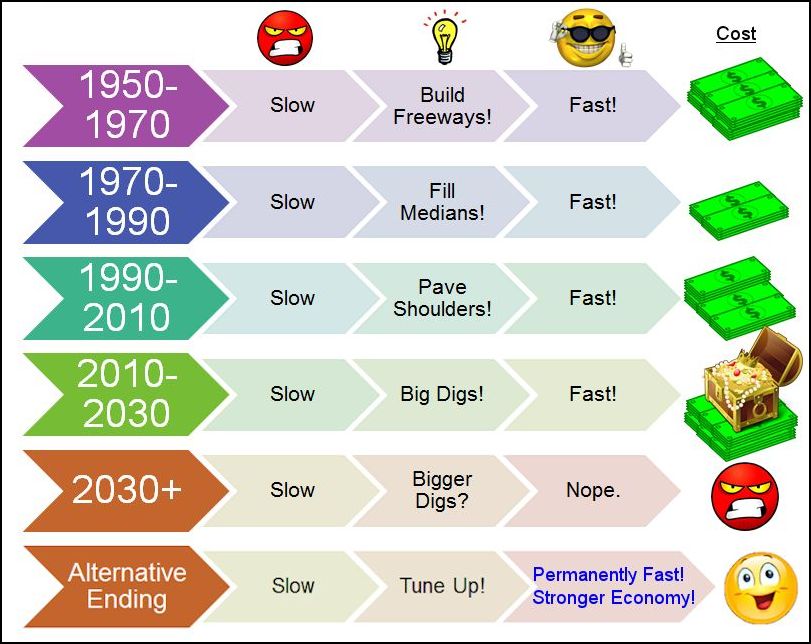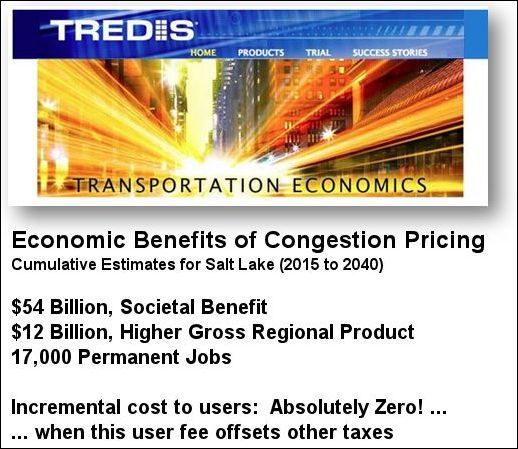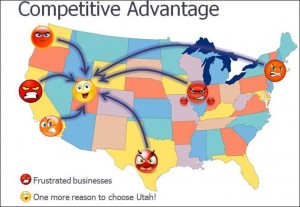This is the second part of a four-part series.
Part 1 ◊ Part 2
Part 3 ◊ Part 4
As I contended in my last post, Americans can do mountains of good for sustainability by using free-market pricing tools to solve traffic congestion. In this piece, I will argue that the first state to get serious about Freeway Optimization will enjoy a competitive advantage over all others.
The argument for how your community can become a billionaire has two parts. First, if your neighbors commit to Big Digs but your state solves the problem without construction, then you’ll save those construction costs while others mire themselves in debt. Second, Big Digs temporarily reduce congestion locally while Freeway Optimization solve congestion regionally. The resultant reliability and time savings will translate into financial and societal benefits worth billions of dollars.
Building our way out of congestion
In the 1950s, it was hard to go very far by auto, so transportation planners invented freeways. Those worked great for 20 years or so, but they motivated people to adopt far-flung lifestyles. It was cheap and easy to add capacity by filling the medians, but then the freeways bogged down again. Next, transportation departments paved the shoulders. Now we have freeways with five to eight lanes each direction, and the latest talk is how to “solve” the worst sections with double-decker freeways! That strategy may work a while, just as previous palliatives did. But the cost of these Big Digs and Double Deckers will be so high that our children will be in debt forever. Has anyone looked at the national debt clock lately?

Adding capacity without adding lanes
Freeways can carry 2,200 vehicles per hour per lane, but only for about 10 to 15 minutes before they gum up. The next several hours are not merely slow but they move only about 60% to 70% of what they are designed to carry. It’s like having a V-8 engine that can do zero to 60 in five seconds but sputters because three cylinders stop firing when you need them most! Years ago our freeways were like modest V-4s. When those sputtered and gave us three-cylinder performance, we installed V-6s, which also sputtered and gave us only V-4 performance. Then we installed V-8s and got only five to six cylinders of performance. Now we’re visiting the mechanic again, asking what it takes to install a V-12 into our Honda Civic right-of-way. The engineers tell us they can double-deck two V-6s for a few billion.
As an engineer I talk to many other engineers. Many are accustomed to adding lanes as the way to boost capacity. But, like the maxim that “a penny saved is a penny earned,” improving efficiency of existing lanes adds as much capacity as building new lanes. Don’t double-deck two V-6s. Your wife will be embarrassed by your soon-to-sputter monstrosity, and you’ll never have the money to take her to Hawaii. Try a cheaper, more sustainable “tune-up” so you can get the V-8 performance you are already in debt for. Then let the next generation decide if it makes sense to go with the V-12.

Freeway optimization strengthens the economy
What if you could make $2 back for every $1 you spend? Would you call that $1 a loss or an essential part of your success? It happens all the time in America – we call it the free market. Citizens worry that pricing is a tax that just drains the economy and gives little back. Yet money for infrastructure, which is essential to economic success, has to come from somewhere! Creating a targeted user fee need not increase overall taxes – it just changes the collection strategy for the purpose of giving people an incentive to avoid the fee, which in turn optimizes freeways and establishes a sustainable system where the city can grow indefinitely without resorting to double-decker freeways.
Time is money, and when businesses and productive individuals can get around by freeways as well as good alternatives, they will turn their time savings into wealth for the regional and national economy. Using TREDIS economic impact software, my firm tested what congestion pricing could do for Utah’s Wasatch Front in 2040 compared to the region’s 2040 plan. The accumulated result over 25-years (2015-2040) was approximately $50 billion worth of societal benefit, $12 billion in higher Gross Regional Product and 17,000 permanent jobs. These benefits will far exceed what users pay over that period for congestion pricing, and there is effectively zero cost if revenues raised are merely offsetting other taxes that would have been needed instead.

Live like no one else… so you can live like no one else
The benefit/cost ratio of freeway optimization blows away almost any other type of highway improvement. Assuming economic impact comparable to that in the Salt Lake region, the strategy could create trillions in productivity gains if applied nationally. The first region to embrace it will have a major competitive advantage over all others.
While business and community leaders may initially balk at the idea of paying a monthly bill for what they previously paid for just at the pump, they should be excited by the wealth that increased mobility and reliability can generate. Opting for a V-12 rather than a simple tune-up? That’s worse than penny wise and pound foolish. It is billion-dollar foolish.
Talk radio financial advisor Dave Ramsey advocates, “Live like no one else, so that later you can live like no one else!” By that, he means work to both reduce expenses and increase income to get out of debt — the path from rags to riches. Let’s apply Dave’s advice and stop debt-financing wildly expensive ways to “build our way out of congestion” and instead use economically catalytic, market-driven strategies to “plan our way out of congestion.”
Michael Brown is president of Metro Analytics of Salt Lake City, Utah.



